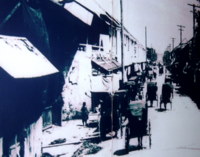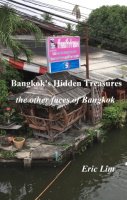- Home
- Chinatown Bangkok
- Yaowarat Heritage Centre
Yaowarat Heritage Centre
the history of Chinatown Bangkok
By Eric Lim
The Yaowarat Heritage Centre covers the history of the early Chinese immigrants to Bangkok, their integration into Thai society and the growth of Chinatown Bangkok with Yaowarat Road as the main thoroughfare.
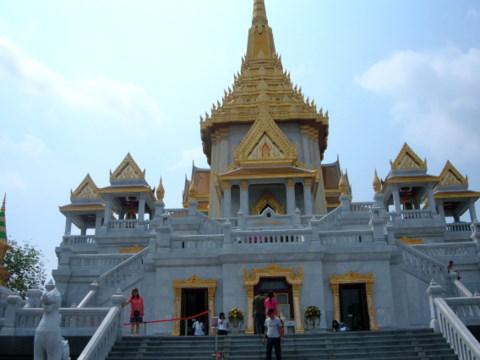
Located on the first level of the building that houses the famous Golden Buddha in Wat Traimit, the museum is organized as a U-shaped room divided into several areas.
Visitors enter through a door on the left to embark on a memorable historical journey.
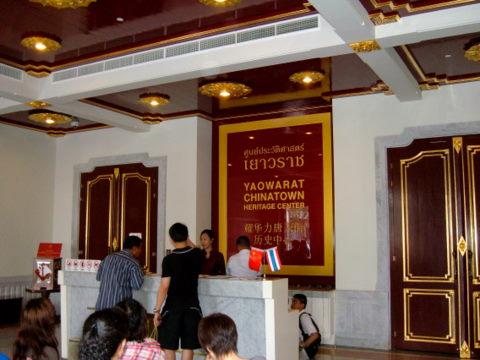
The reception area, entrance to the display area is on the left
How to get to the Yaowarat Heritage Centre
A glimpse into the past
The first stop in our tour of the Yaowarat Heritage Centre is a video show in which life-sized images are projected on to an actual physical setting for a three dimensional effect.
In the story set in a typical Chinese home, a grandfather tells his grandson about life in Yaowarat Chinatown in the 1940s.
Grandpa relates with pride the royal visit by King Rama VIII and his younger brother, the present king, King Rama IX. The royal entourage passed the front door of Grandpa’s family home.
This technique of using characters in a present day setting to relate historical events, with flashbacks to the past, is an interesting way of presenting history.
Early history 1782 - 1851
The early history room in the Yaowarat Heritage Centre relates the history of the Chinese in Bangkok and Thonburi. When the Grand Palace was built, the Chinese settlement which was located there was moved to Sampheng the origins of Chinatown Bangkok.
The Chinese population in Thailand grew in the first three Reigns of the Chakri Kings through free immigration. Famine in southern China caused many Hokiens and Teochews to migrate to Southeast Asia.
The new immigrants can belong to an official and do compulsory work, in which case they are tattooed on their wrists. Or they can pay a government tax and be free to seek employment. These people will have a token tied around their wrist.
Trade between China and Thailand grew at the same time as Chinese migration. The Chinese junk became a familiar ship in Bangkok and Sino-Thai trade peaked in the reign of King Rama II.
Life in the old days
From this stage, things at the Yaowarat Heritage Centre start to get interesting. At first glance, this room appears to be a store room with various goods stacked in shelves.
It’s a simulated view of the deck of a Chinese junk as seen from the hold below where the visitors are located. The visitors are actually in a room made up to look like the hold and the images are projected on the ceiling with very realistic audio and visual effects.
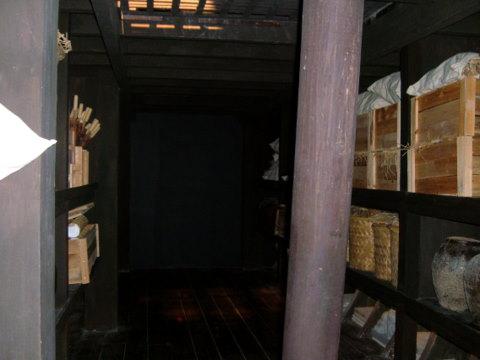
In the eye of the storm
Early Chinese immigrants leave their impoverished homeland in southern China to take a hazardous sea journey to Bangkok and other parts of South-East Asia. They brave storms and rough seas in the hope of finding new and better lives.
As you enter lightning flashes overhead, the crash of thunder drowns the desperate cries in Teochew. From an opening above, water “splashes” in. You are in the hold of a Chinese junk carrying immigrants to Bangkok. The junk is caught in a thunderstorm, a condition very realistically simulated by imagery, light and sound.
The storm subsides and the immigrants wake to a new dawn, catch sight of their new homeland and give thanks for a safe journey.
Moving on through this section of the Yaowarat Heritage Centre, we enter narrow alleys filled with street vendors.
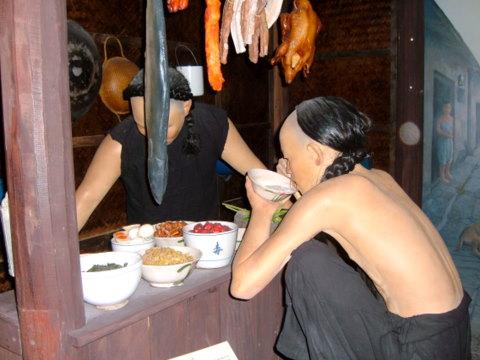
It was common for the working class to sit this way in those days
These are displays of life sized models depicting street life in Chinatown of old. You can hear the vendors call out in their native Teochew to passing customers.
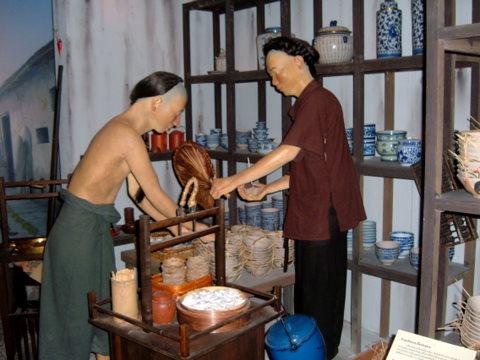
Street food
History 1851 – the present
In this history room events unfold in relation to the reigns of King Rama IV – King Rama IX, major events in the world, China and their impact on the Chinese in Thailand.
Yaowarat Road was built in 1891 in the reign of King Rama V. It has been said that this 1.5 km road weaves through the heart of Chinatown Bangkok like a dragon.
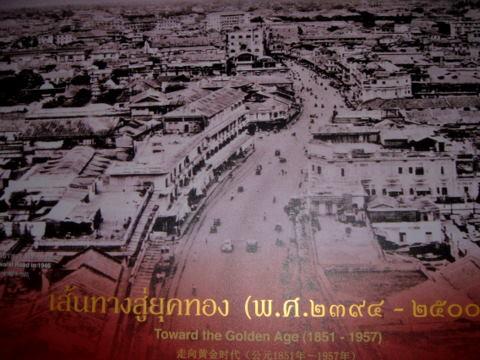
The dragon at the turn of the 20th century
The name Yaowarat, meaning “young king”, was bestowed by King Rama V in honour of his son, Crown Prince Maha Vajirunhis.
The advent of the steamship resulted in a reduction in trade with China as Thailand switched to trade with the West. However, the steamship brought even more Chinese immigrants. Between the World Wars from 1918 to 1931, Chinese immigration hit 1.3 million.
A significant development in the first half of the 20th century was the rise of Chinese nationalism. Dr Sun Yat Sen, the father of the Chinese republic, visited Yaowarat when he came to Bangkok in 1910. Soi Sun Yat Sen is named in his honour.
The Sino-Japanese War in the 1930s gave rise to strong anti-Japanese sentiments in Chinatown Bangkok. Like many South-east Asian cities with an ethnic Chinese population, Bangkok’s Chinese boycotted Japanese goods and supported the war effort back in China.
The situation of the Chinese in Thailand was further complicated by the Thai government’s collaboration with Japan during World War II.
Nostalgia
This section of the Yaowarat Heritage Centre features old pictures of Chinatown Bangkok and scaled models of scenes of life in the old days.
There’s also a scaled model of Chinatown Bangkok in the centre of the room.
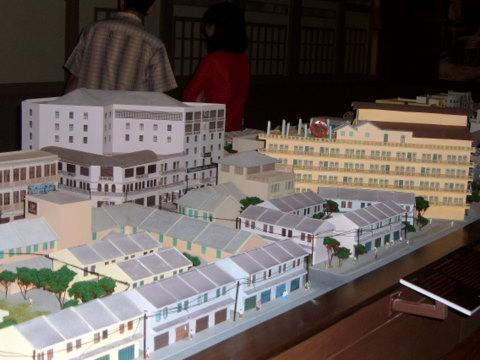
Overview of Chinatown Bangkok
The photo below was taken at the junction of Yaowarat Road and Ratchawong Road. The building on the left, Kao Chan (nine stories) was the tallest building in Thailand at that time!
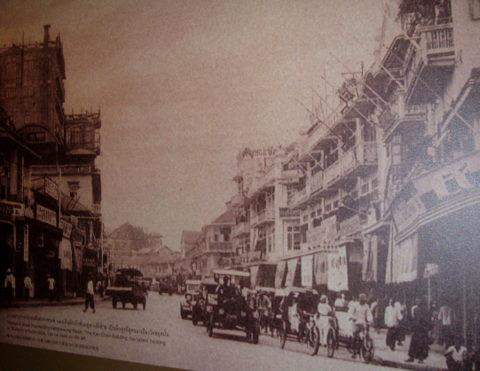
Tallest building in Thailand (left)
In 1894, an electric tram car service passed through Charoen Krung Road and Yaowarat Road. This service only ceased in 1968.
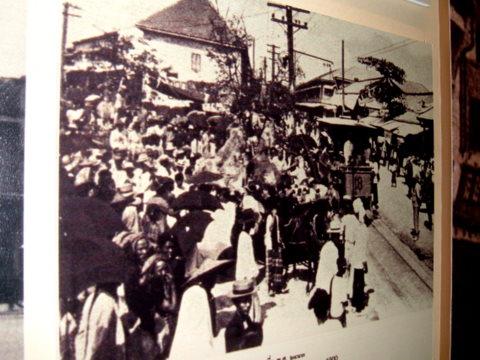
Old tramcar service
Besides these old photos, I particularly like the scaled models depicting life in old Chinatown Bangkok.
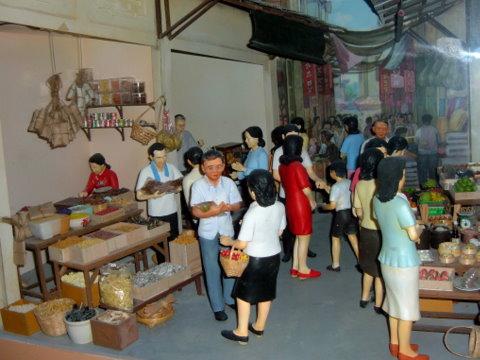
Meeting friends at the market
We probably will not get to see these scenes again today.
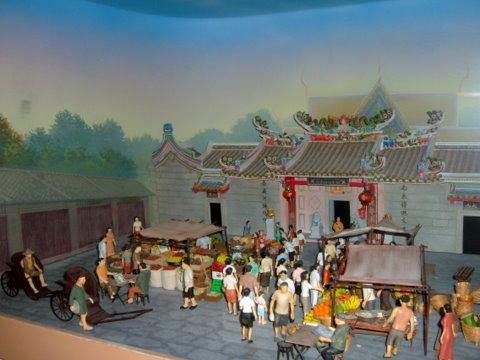
Temple scene, note the old rickshaws drawn by men
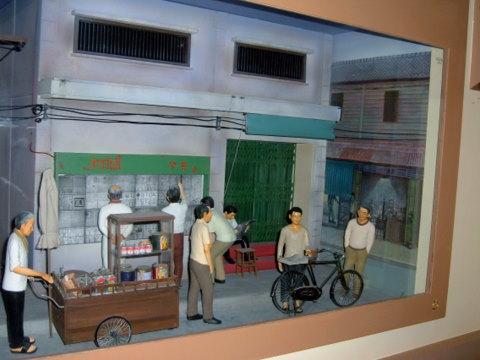
Catching up on the news
Sino-Thai relations – memorable moments
The Yaowarat Heritage Centre dedicates a room commemorating Sino-Thai relations with memorable photos of Chinese dignitaries visiting Thailand. This shot is historic. Deng Xiao Ping was the first Chinese leader to visit Thailand.
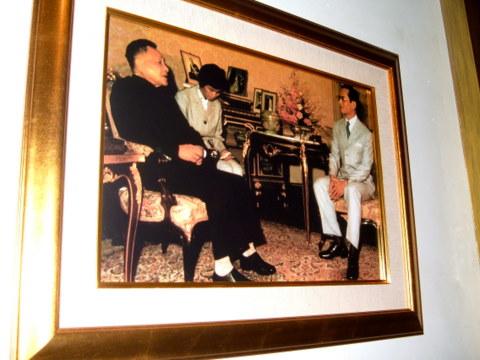
Deng Xiao Ping in a royal audience with HM the King – 5 Nov 1978
Thailand established formal diplomatic ties with China on 1 July 1975. Deng’s visit paved the way for further high level visits. President Jiang Ze Min visited Thailand in September 1999.
Chinatown Bangkok scenes
Regardless of modernization and development, these images of Chinatown will linger on.
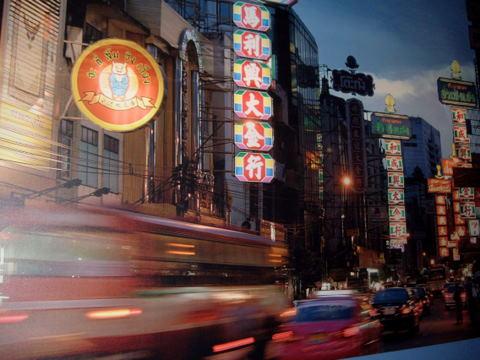
Yaowarat by night
The street operas provided free entertainment in the evening.
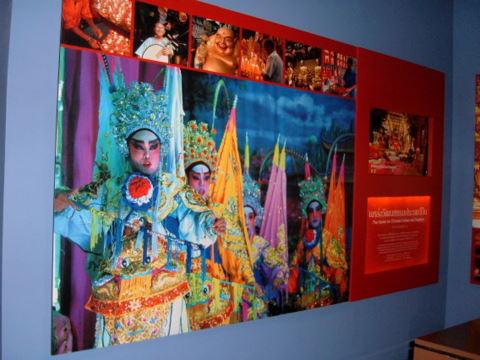
Chinese opera
Though the development of spanking department stores set a new shopping trend from the late 1960s, Chinatown Bangkok still retains its popularity for retail and wholesale trade in Chinese goods.
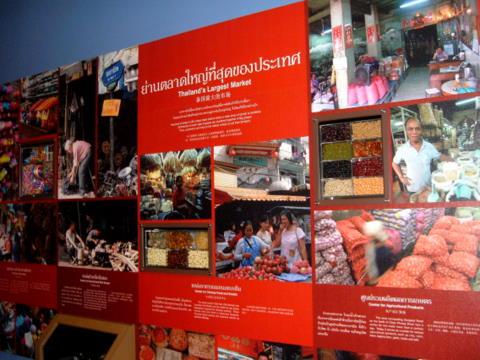
Chinatown’s markets, a wide array of Chinese goods
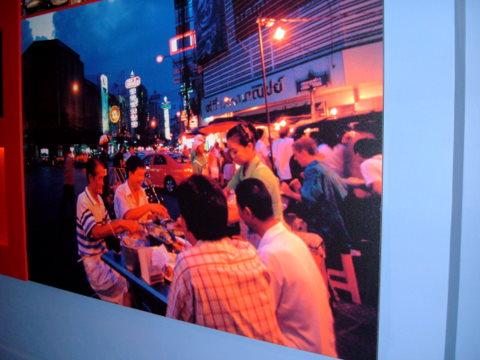
Street dining
And of course for restaurants and street food, Yaowarat is second to none.
We emerged from the other door in the Yaowarat Heritage Centre to return to the present, after a journey through a few centuries of history of the early Chinese immigrants in Bangkok.
The Chinese community in Thailand has come a long way since those tough early days. So has Chinatown as a landmark in modern Bangkok today.
The map below shows the way to Wat Traimit in Chinatown Bangkok. The Yaowarat Heritage Centre is located on the first level of the building housing the Golden Buddha.
View Wat Traimit in a larger map.
Go to top of page
The easiest way to get there is to take the MRT Blue Line to BL28 Hua Lam Phong Station and walk to Wat Traimit.
The Yaowarat Heritage Centre is open every day from 0900 – 1700 hours except on Mondays.
Admission used to be free when it first started.
In a recent visit on 4 May 2011, I discovered that admission is now 100 baht.
This includes visits to the heritage centre, the Golden Buddha Museum on floor above and the Temple of the Golden Buddha on the top floor.
To return to Chinatown Bangkok and for other Bangkok Museums.
Another Chinese heritage museum
Bangkok’s Hidden Treasures – the other faces of Bangkok
This is my third e-book which is a journal on my travels in Bangkok from late 2011 to early 2018. It’s a journey to the less traveled and lesser-known places in Bangkok, places that are treasure troves of history, art and culture of the diverse communities that make up Bangkok and Thailand.
This journey will take us from the rice fields of Nong Chok near the eastern city limits of Bangkok across the city to the canals in Thawi Wattana in the west.
Let's uncover these gems in Bangkok's hidden treasures together.
Search Tour Bangkok Legacies with DuckDuckGo
Another Chinese heritage museum
My Journey through Thailand
Part I The First Steps
My Kindle edition

My Smashwords edition

Tour Bangkok Legacies
new discoveries of old treasures
My Kindle edition

My Smashwords edition

Chinatown hotels
Bangkok Centre Hotel
Check Inn Chinatown
Chinatown Hotel
Grand China Princess Hotel
Shanghai Mansion Boutique
SK Boutique Mahanakhon Hotel
